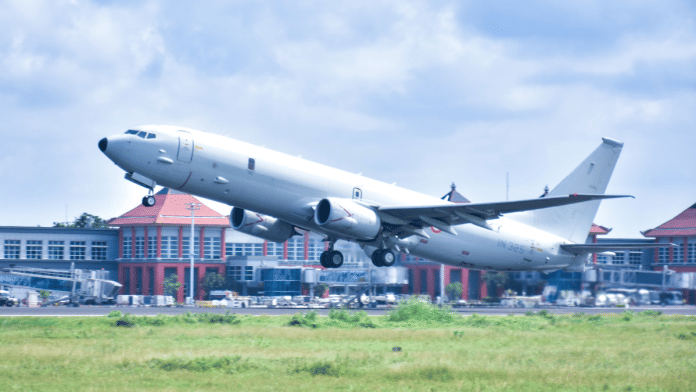New Delhi: Pakistan was “vigilantly watching” Indian Navy’s maritime reconnaissance aircraft P-8I, the Pakistan Navy spokesperson said Monday in an apparent bid to showcase its surveillance capabilities in the backdrop of heightened tensions.
Irrespective of Pakistan’s claim, the Indian Navy’s aircraft was flying in international airspace and broadcasting its location on FlightRadar24, an open-source flight-tracking platform accessible to any party with an internet connection.
Sources in the Navy told thePrint that the presence of the P-8I in the Arabian Sea and the Indian Ocean Region is a regular occurrence. The aircraft has frequently been involved in anti-piracy missions, operating alongside Navy’s Marine Commandos (MARCOS) and contributing to broader maritime domain awareness.
ThePrint looks at the P-8I long range maritime patrol aircraft, nicknamed India’s Eye in the Sky’, and its crucial role it essays for the Indian Navy.
Also Read: Pakistan-linked cyber-attacks intensify as defence websites, veterans’ platforms targeted
A flying destroyer
The Boeing P-8I Poseidon, adapted from the Boeing 737 airframe, is the Indian Navy’s most advanced long-range maritime patrol aircraft.
India inducted its first P-8I in 2013 after signing a $2.1 billion deal with the US in 2009 for eight aircraft. A follow-on order for four more was placed in 2016, with the final aircraft delivered in 2021. Furthermore, India is in talks to likely acquire 6 more aircraft.
Originally developed to replace the US Navy’s ageing P-3 Orion fleet, the P-8I has been tailored to Indian operational requirements under a defence agreement with America.
The aircraft come with a combination of American systems and indigenous technologies developed by Indian defence public sector units and private manufacturers.
P-8I’s capabilities are built around endurance, altitude and payload. It can fly up to 41,000 ft, remain airborne for over 10 hours, and cover over 1,200 nautical miles per mission—thereby, suitable for extended surveillance over both coastal and deep-sea theatres.
What makes it suitable for tracking submarines is the Magnetic Anomaly Detector (MAD) that can sense minor disturbances in the Earth’s magnetic field caused by underwater metal objects like submarine hulls, while expendable sonobuoys acoustically track submarine activity below the surface.
Its arsenal includes AGM-84L Harpoon Block II anti-ship missiles, Mark 54 lightweight torpedoes, depth charges and free-fall bombs. These capabilities make it a formidable anti-submarine warfare (ASW) platform, a critical asset in tracking potentially hostile submarines in contested waters and earning it the moniker of “flying destroyer.”
From seas to the Himalayas
Despite its primary maritime role, the P-8I has repeatedly proven useful in land-based operations as well.
The aircraft, according to sources in the defence, was used to monitor Chinese military deployments over the Himalayas during the 2017 Doklam standoff, a non-traditional environment for a naval aircraft.
Reports further indicate that a similar deployment followed the Pulwama terror attack in 2019, when the P-8I was reportedly used to monitor Pakistani military activity near the Line of Control (LoC).
Similarly, it was also engaged in post-Galwan operations in 2020, assisting in intelligence-gathering and data relay.
The sources indicated that the P-8I became a semi-permanent presence in the northern theatre due to a capability gap in the Indian Air Force’s Intelligence, Surveillance, Target Acquisition, and Reconnaissance (ISTAR) assets. It helped bridge that gap with real-time imagery and data relay, directly aiding Army formations in contested zones along the Line of Actual Control (LAC).
P-8I has thus evolved into a strategic asset that serves beyond its original maritime mission, operating across land and sea in both conventional and grey-zone scenarios.
In addition, the aircraft’s versatility extends to peacetime missions as well. It has supported search-and-rescue efforts, anti-piracy patrols in the Indian Ocean Region and environmental monitoring operations.
A notable episode took place in 2018, when a P-8I flying out of Mauritius helped locate the damaged sailing vessel S.V.Thuriya. The boat was carrying Indian naval officer Commander Abhilash Tomy (retired), who was injured in a storm and was stranded in a remote region of the Indian Ocean. The aircraft’s long-range sensors played a critical role in narrowing down the search zone and ensuring his rescue
(Edited by Tony Rai)
Also Read: Defence stocks surge continues amid escalating India-Pakistan tensions since Pahalgam attack






